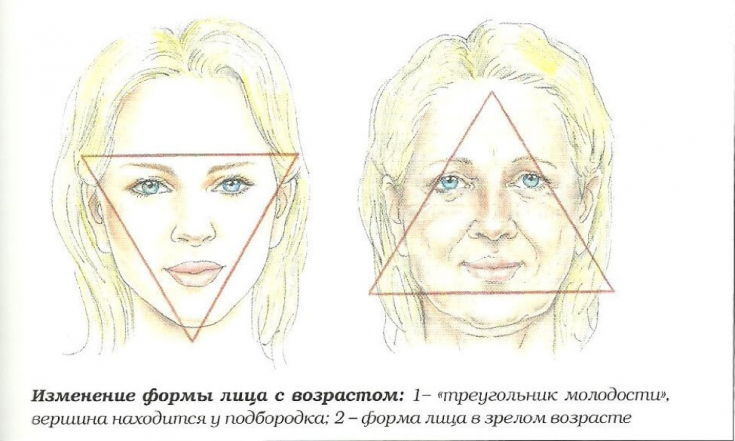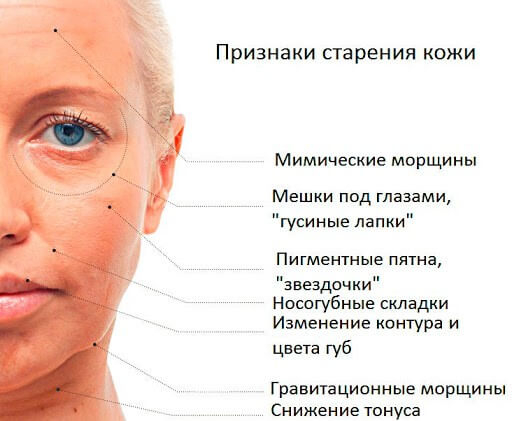Women in their thirties, when looking at themselves in the mirror, notice individual wrinkles on their faces. This may be a sign of premature skin aging. These features include:
- static wrinkles;
- creases;
- lentigo;
- skin roughness;
- senile purpura.
Skin aging is subject to genetic factors, exercise, sleep disturbances and hormones.
Find out in the article on estet-portal.com what mechanisms of skin aging occur at the molecular level, what factors stimulate this process, and the role of hormonal influences at different age stages of a woman's life .
- Histological and clinical signs of skin aging
- Peculiarities of skin aging after 40 years
- The impact of skin aging on the psychological status of a womanna
Histological and clinical signs of skin aging
Histologically, chronological skin aging is characterized by:
- reducing vascularity;
- thinning of the dermis;
- decrease in the cellular composition of the dermis;
- loss of elastic fibers.
Follow us on Instagram!
Clinically, such changes are manifested:
- loss of normal skin color;
- skin atrophy;
- wrinkles;
- sagging skin.
It has been shown that the abuse of ultraviolet irradiation before the age of 20 causes accumulation of the photoinduced effect in 80% of women.
How to keep a natural face after rejuvenation with fillers
The main clinical manifestations of this process on the skin side are:
- lethargy;
- coarseness;
- yellowish tint;
- uneven pigmentation;
- telangiectasias.
Histologically this picture is characterized by:
- epidermal atrophy;
- acanthosis;
- keratinization disorder;
- disappearance of melanocytes;
- loss or degeneration of elastic filaments
on; destruction of vessels. - Peculiarities of skin aging after 40 years
Even greater age-related changes are observed in women 40-50 years old. As women age, their skin needs moisture. Dryness is histologically associated with thickening of the stratum corneum, and is thought to be
resulting from clutch shift and maturation of keratinocytes.
Hydrolifting: reinforcement and biorevitalization in one procedure Frequent application of moisturizers helps the skin stay hydrated and soft. Although humectants are made up of oil and water, only a minimal amount of water is absorbed by the stratum corneum.

When a woman enters the perimenopausal period, the skin signs of aging become more pronounced
due to the loss of endogenous estrogen. The relationship between estrogen and the skin is quite complex, as it is influenced by estrogen levels, receptor status, and other circulating hormone levels. Studies have shown that the decline in dermal collagen levels is approximately 2% annually at menopause.
Hair changes occur before and after menopause. During this period, women experience estrogen suppression
and a relative rise in androgens. Influence of skin aging on the psychological status of a woman
Even before that time, which can be safely called old age, there is a period of late maturity, delicately called by some authors. During this period, the changes may be more significant, since
the psychological reaction to them is stronger than at puberty.The process of maturity is gradual and slow, with suppression of cell size and number, as well as the exclusion of many functions associated with systemic changes in menopause, when the production of ovarian sex hormones decreases.

A significant number of pathological changes typical of late adulthood belong to the psychological aspects of chronological and hormonal aging. But on the skin side, this process is
the result of programmed aging in each individual.
Laser skin rejuvenation with ablative lasers: mechanism of action and indications The cellular level of aging is a form of genetically programmed differentiation, expressed in
expansion of the proportion of more differentiated cellsand loss of relatively undifferentiated cells, which have a greater proliferative potential and a large functional response. Studies have shown that age-associated differentiation depends on gene expression. An important external influence on the normal aging process of the skin is the abuse of smoking and ultraviolet rays. Most of the cellular processes associated with skin aging
are accelerated in photoinduced cells, including genetic mutations with a higher differentiation threshold, which increase the harmful effects of ultraviolet radiation.
Perfect neck and décolleté care Natural aging can be characterized clinically as
the appearance of wrinkles, loss of elasticity, atrophy of the dermis, reduction of subcutaneous tissue.Functionally, this contributes to an increase in the sensory sensitivity of the skin, as well as a loss of the skin's ability to:
epidermal renewal;
- cleansing from chemicals and external influences;
- restoration of the dermis;
- wound healing;
- mechanical protection;
- immune response.






